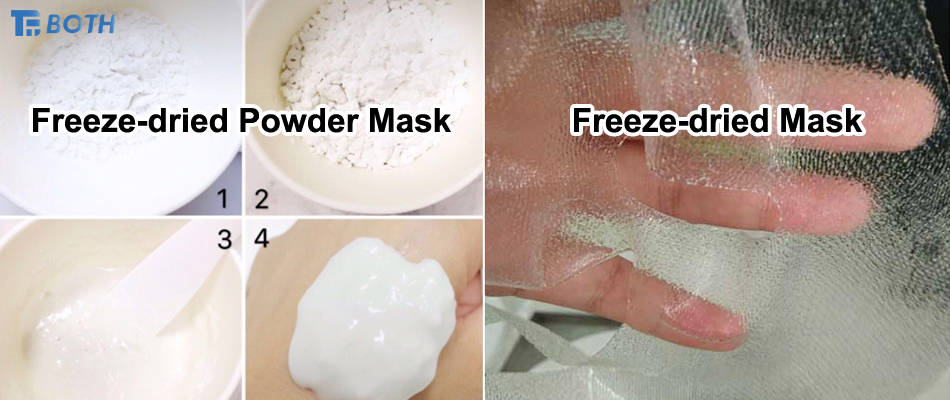Freeze-dried face masks are currently a popular choice for those seeking a healthy, additive-free, natural skincare option. The manufacturing process involves using “BOTH” brand freeze-dryers to convert the liquid water content in bio-fiber masks, which are free from any chemical substances, into solid ice crystals under low-temperature conditions. These ice crystals are then sublimated into a gaseous state through vacuum temperature control, resulting in the final freeze-dried face mask.
Freeze-dried face masks prepared through this method can be stored for long periods. More importantly, because they are dried at low temperatures, the masks retain their original biological activity and active ingredients. The freeze-drying process does not involve the addition of any reagents or chemicals, and the mask is ready for use simply by adding clean water for rehydration.
The Freeze-Drying Process: The freeze-drying process begins by blending the mask's nutrient solution, moisturizing agents, and other ingredients to form a homogeneous nutrient liquid. This liquid is then combined with the mask's fiber material, followed by low-temperature freezing and vacuum drying in a freeze-dryer to create the final freeze-dried face mask, which is then sealed in packaging. The freeze-drying process consists of three stages: pre-freezing, primary drying, and secondary drying.
Pre-freezing: The fiber material, containing nutrients, is frozen at -50°C in an ultra-low temperature freeze-dryer for about 230 minutes.
Primary Drying: The vacuum freeze-drying machine controls the primary drying temperature between -45°C and 20°C, with a controlled vacuum of 20 Pa ± 5. This stage lasts approximately 15 hours, removing about 90% of the moisture from the material.
Secondary Drying: The freeze-dryer then performs secondary drying at temperatures between 30°C and 50°C, with a vacuum control of 15 Pa ± 5. This stage lasts about 8 hours, removing the remaining 10% of moisture from the material.

Advantages of Freeze-Dried Face Masks:
Low-Temperature Drying: Since freeze-drying occurs at low temperatures, proteins are not denatured, and microorganisms lose their biological activity. This method is particularly suitable for drying and preserving biologically active products, biochemical products, genetic engineering products, and blood products, which are sensitive to heat.
Minimal Nutrient Loss: Low-temperature drying minimizes the loss of volatile components, heat-sensitive nutrients, and aromatic substances, making it an ideal drying method for chemicals, pharmaceuticals, and food products.
Preservation of Original Properties: The growth of microorganisms and enzyme activity is nearly impossible during low-temperature drying, which helps preserve the original properties of the material.
Retention of Shape and Volume: After drying, the material retains its original shape and volume, remaining sponge-like without shrinkage. Upon rehydration, it quickly returns to its original state due to its large surface area in contact with water.
Protection from Oxidation: Drying under vacuum reduces oxygen exposure, protecting substances that are prone to oxidation.
Extended Shelf Life: Freeze-drying removes 95% to 99.5% of the moisture from the material, resulting in a product with a long shelf life.
The freeze-dried face masks processed with cosmetic freeze-dryers offer excellent moisturizing effects, nourish and tighten the skin, minimize pores, and leave the skin soft, elastic, and rejuvenated. Since they are free from additives and preservatives, they are highly safe to use, making them a favorite among consumers!
"If you are interested in freeze-dried face masks or would like to learn more about our products and services, please feel free to contact us. We are happy to offer advice and answer any questions you may have. Our team looks forward to serving you and working with you in the future!"
Post time: Sep-06-2024







